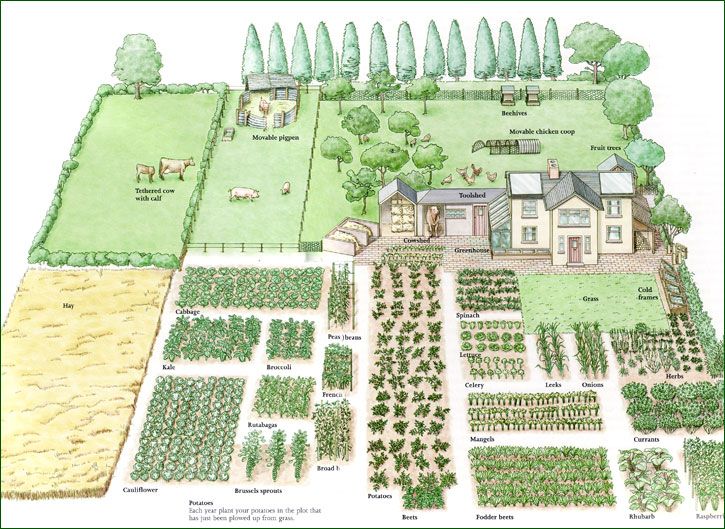Email a copy of 'Homestead Design from a Practical, Tactical, Agricultural Survival Perspective, by C.F' to a friend
7 Comments
- Ad Survival RealtyFind your secure and sustainable home. The leading marketplace for rural, remote, and off-grid properties worldwide. Affordable ads. No commissions are charged!
- Ad California Legal Rifles & Pistols!Get the firepower necessary to survive in restrictive states! WBT offers California & other state compliant rifles from any brand you want.


Very good synopsis of setting up a homestead, but he left out one important factor, power. When in the planning stage it is important to decide if the property is suitable for renewable power of some sort. This in turn will lead you to the layout of the home and other out buildings to maximize solar efficiency.
Excellent article. Your septic system also needs to be down slope from your home, so assure you have separation between that and your garden, gray water system.
The author mentions how wonderful the mountains are and how good the water may be for irrigation among other things.
I’ve lived in the mountains and now farther east. It is far, far better to live where irrigation is not necessary, not only because of the lessened effort and expense but also because the added humidity helps plant growth and stabilizes the growing season.
Good points, commenters.
Good growing land usually includes good solar panel mounting locations. Getting these within proximity of where the power will be used, is helpful. (Large-gauge wire, needed for long runs, is expensive!) Wind and water power are also considerations to factor in, but they tend to be more troublesome due to moving parts and mechanical failures.
Moist climates have advantages in not needing supplemental irrigation. The downside is usually (1) increased population density, and (2) mycological overgrowth in forms of must, mold, mildew, etc.
The Redoubt is usually moderate to arid.
52 inches of rain per year (1 inch per week) would allow for an average that would eliminate the need for irrigation. However, droughts in these non-irrigated areas are still devastating.
An annual precipitation of 30 inches per year is often a happy medium. This will require something like half the water to be supplied by irrigation.
In my area, May and November tend to be the wettest months.
The period when seeds are sprouting is the time when the most water is required, at the most frequent intervals. After the plants are established, the root systems can pull water up from farther down.
In our dry Redoubt home area our best pumpkin patch grew over the septic drain field. Our gray water was ineffective for even a yard. Too much detergent.
Good article.
Before soil should come location’s security and privacy.
Soil can be built up with raised gardens, terraces, etc, given time. For more arid environs, Brad Lancaster’s Rainwater Harvesting book series is quite good guide on this on traditional farming techniques in the American Southwest. Lots can be learned from permaculture too.
Rain matters, water sources matter, etc, but given law of averages one can put in enough rainwater storage to get through most times. Redundancy is good however — and if implementing rainwater harvesting practices, A LOT of water can be banked into the soil.
Insofar as mulch, don’t discount native prairie grasses (many vineyards and orchards in places ranging from desert SW to california are going that route as better than other options) — 6+ roots allow water penetration through harshest soils and them being much more water efficient than introduced grasses too to the tune of most needing rain only once per month save hottest parts of year in the south, and shading and covering soil massively reduces soil evaporation and they add/support more diverse soil biocultures and b/c they are rooted in the soil hold more soil in place from wind and water erosion and finally they amend the soil w/ dying vegetation that builds more soil over time.
Basically, if the land can grow grass or the lack of grass is due to irresponsible land management/overgrazing, then some sort of crops can be grown.
Author is correct — in the far south US, north and east slopes are in fact preferable vs south or west for more temperate regions…
My only gripe with the author is his perimeter patrol… If looking for WROL type scenario, there are a lot of brush and briar etc outer fences that can be created that help to disguise settlement beyond that barrier, if looking at it from a permaculture perspective, this would be zone 5 around the property’s perimeter. Your livestock, security, or similar fence should be between permie zones 4 and 5 with your patrol track around the outside of zone 4. Granted, ideally you’d be able to overwatch zone 5 (and zone 4) to ensure safe prior to patrolling (or to provide overwatch and/or in lieu of patrolling ample tech, sensors, and cameras, well disguised, would be good replacements), but patrolling on a set path in a set manner everyday during a WROL scenario is exceptionally dangerous.
If your property is directly on a busy public road with neighbors having consistent perimeter fencing as well, you’d be foolish to not have that as well, but then that location is not ideal…
To a commenter above, rainwater storage flush water can be directed to graywater tanks to dilute soaps — and definitely take a look at more natural soaps like Dr Bonners for the shower (and they’re better for your skin too).
Excellent article, a lot of good information. All things to think about when buying land.